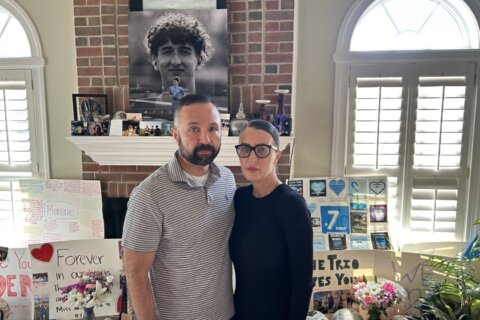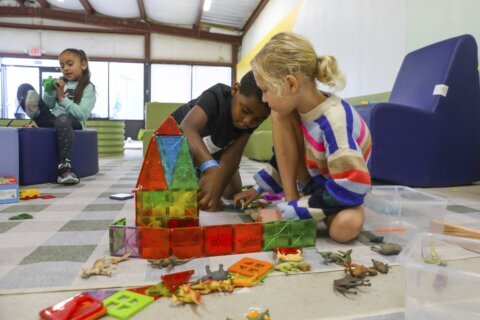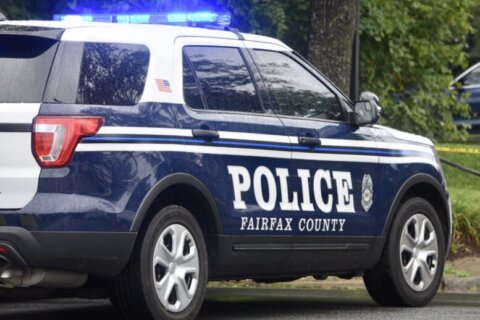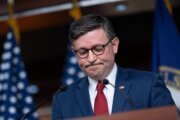The signage reminding students to stay 6 feet apart is already on the floors. The plexiglass is up in the front office. The desks are spaced in a socially-distanced way in the classrooms.
This is how Mantua Elementary and all other public schools in Fairfax County, Virginia, are preparing for back-to-school in the age of COVID-19 as the district’s superintendent says “you can’t put every kid back in a school.”
For now, students in this suburban school system, one of the largest in the nation, will only come physically back to school in a limited way: two days a week in the classroom. The rest will be virtual, and parents also have the option to keep their kids home entirely.
Scott Brabrand, the superintendent of Fairfax County Public Schools, says this is the best option they could come up with to comply with US Centers for Disease Control and Prevention guidelines.
“We’re going to have PPE for all of our teachers and students, and we’re going to have a return to school in a new normal for Fairfax County and for school districts across the country,” Brabrand said during an interview in a classroom amid desks stationed 6 feet apart.
Education Secretary Betsy DeVos repeatedly calls out Fairfax County, Virginia, criticizing the school system’s current plan for only two days a week in the classroom as insufficient. Devos has noted that it is well funded in one of the wealthiest parts of America.
“I would call it an elite public school system in America — offered families a so-called ‘choice’ for this fall, and their springtime attempt at distance learning was a disaster. I give this as an example because things like this cannot happen again in the fall. It would fail America’s students, and it would fail taxpayers who pay high taxes for their education,” DeVos said during a coronavirus task force press briefing last week in which she pushed hard for America’s schools to reopen full time.
“COVID hits all of us, and the guidelines for 6 feet social distancing simply mean that you can’t put every kid back in a school with the existing square footage footprint. It’s just that simple,” Brabrand said flatly in response to DeVos.
He argues that they may have plenty of resources, but that doesn’t make it any more feasible to pack students into schools and still follow social-distancing guidelines.
“This is the American Dream, American public education. We’re here to offer it to all of our students and families, and those that would critique it, I don’t think have the best interests of public education and of the United States at heart,” he said, with a not-so-subtle dig at DeVos, whose goal is to move more public funds with students into private schools.
Fairfax County is one of the largest school districts in the country with more than 188,000 students in grades pre-K-12.
Brabrand said that in normal times, students are on average about 18 inches away from one another, and he calculates that in order to have enough space for all of his students to social distance, they would almost need another school system of 200 sites.
To make his point another way, he said the school system is the size of “five Pentagons.”
“You would need another five Pentagons of space to be able to safely accommodate all of the students in Fairfax County Public Schools,” he said, which would not only be expensive but not feasible to build in the next six weeks before school starts.
“What we’re doing is the best that we can under the constraints of COVID-19,” he insisted.
Parents hoping for better
Fairfax County parent Miriam Aguila says she hopes that the best the school system can do looks a lot better than it did in the spring for her daughter, a rising kindergartner, and her son, who’s going into third grade.
She was frustrated with the virtual learning process — noting that it had too many platforms that often did not work properly.
“My son had like 200 emails that I just didn’t have the time to go through,” Aguila said of her then-second grader.
“Getting him logged on, the technical difficulties, just being there. After that, I felt like an IT person, which IT is not my field. So it was crazy,” she said, echoing the frustration and experience of parents across the country.
“There (were) many times where, thank goodness, my job was very understanding where I wasn’t available in the morning and I pushed my work schedule either in the afternoon, sometimes even when they were off in bed because it was quiet,” she recalled.
Aguila is a single mom but considers herself lucky. She can work from home and has help, including from her own mother who lives with them.
“Even my mom being here, even with that help, sometimes you got to be like, ‘Quiet. I’m on a call!'” she said.
“Sometimes I’d be up until 2, 3 in the morning just because when the house is quiet, I could focus. And then you have to be up in the morning trying to do the best you can,” she added.
Despite all that, Aguila plans to choose full-time virtual learning for the fall. She worries about exposing her 71-year-old mother, and also says if there is a spike in the area and the two-day-a-week in-person learning stops, her kids will at least have consistency.
Knowing that CNN was also talking to her school’s superintendent, she passed on a plea for virtual learning to be more streamlined for the fall.
“We had two weeks where we struggled,” Brabrand conceded, but also insisted they “soared” afterward.
“I wish we were able to do that right out of the gate. We have lessons learned, and we are using those lessons to help us be ready to have a successful fall,” he said.
Some of the problems they had in the spring — like securing the systems — have been worked out. But other challenges flagged by Aguila, like using more than one platform, will not change. They still plan to use both “Blackboard” and “Google Classroom.”
But Brabrand insists teachers are getting better training, and that any student with connectivity issues or in need of a computer or I-Pad can get one.
So far, most parents are opting for in-person learning.
As of late Friday, about half of the school district’s students had registered their preference, and Brabrand said roughly two-thirds are asking for an in-person experience, and about a third for virtual.
“A lot of our family and communities want to get back to normal, but we have to do normal in the context of COVID-19. We have to be able to reopen schools in a responsible and safe fashion, for our students, for our staff and for our community,” he said.
Everyone on site will be required to wear masks, including the youngest students, which he admits will be a challenge for the younger children.
“One of the things I told parents already, as you consider your choice about virtual or returned to school, put a mask on your child for a few hours a day now over the summer, see how it is. It’s a new experience for kids. I still believe in the resilience of children. We know that some kids, again, very early ages, that they may struggle with the mask and we need to figure out how we work with those individual kids or provide additional protections for our teachers where there are some situations.”
He said there will be other accommodations for students, including those with special needs, who can’t wear masks.
“We’re going to have PPE in some situations, gloves and gowns and face shields that will provide protection if masks aren’t the way that we can go,” he said.
Teachers’ concerns
Though some data suggest that children with COVID-19 don’t get as sick as older people, experts like Dr. Deborah Birx, the White House’s coronavirus response coordinator, admit that there hasn’t been enough testing to know enough about children, especially when it comes to transmission of the virus. That unknown is leaving teachers across the country nervous about the prospect of spending all day indoors.
In Fairfax County, teachers too will be required to wear masks, even in the front of the classroom, and students who come to school without a mask will have temperature checks.
Brabrand said he wishes they could take it a step further and offer testing for the virus, but it’s not reliable or available yet.
“One of the things in learning with our health department, is you test for that moment in time. Do we have enough testing available in this country to test kids on that regular of a basis, or our faculty? I know that’s something that colleges are looking at, but then our conversations here, one of the questions is, that really is just capturing a moment in time,” he said.
“I don’t think any of us are there yet, in the United States,” he added flatly.
Funding threat
President Donald Trump spent the week aggressively pushing to reopen schools, which is not only important for children’s development but also key to jumpstarting the economy by allowing parents to leave home and go back to work.
Both Trump and DeVos are even threatening to withhold federal dollars for schools that don’t fully reopen.
The reality is that 90% of America’s schools get their funding locally.
In Fairfax County, Brabrand said only 2% of the budget comes from federal dollars.
“It’s not about political games. It’s not about budget fights. It’s about what’s doing best for America in a time of crisis, and we need clear, concise, supportive leadership that says, ‘Do it and do it well, and we’re here to support you. Tell us what you need so that we can make you be successful.’ We need fans of public education to stand up and say, ‘Superintendents across the country, school boards across the country are all trying to do the right thing, and we’re here to support you. Tell us how we can help.’ That is what is going to be the recipe for success this fall,” he said.







